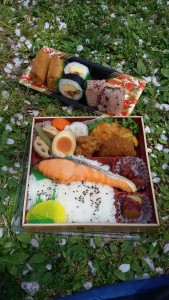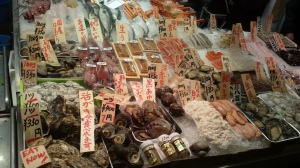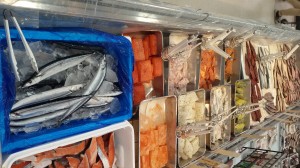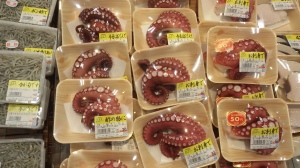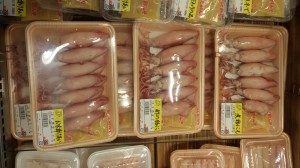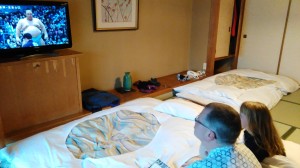Ian has got his hands on the laptop and wants to share his thoughts. I suggest you make a cup of tea and get a comfy seat, as he has a lot to share ….
Chinese vs Japanese.
The guide books advise against making any such comparisons between these nations to the natives themselves as they don’t like to know that anything is better across the sea.
Transport – Japan has its well known train system, which can whisk you anywhere at hundreds of miles per hour. The
Hyperdia website helps you plan and cost your journey. At first you think the transfer times are unrealistic, but the site often tells you at which platform you arrive and at which platform your connecting train leaves from. One minute was our shortest transfer and sure enough, the connecting train was waiting for us. Most tourists have their
JR Pass purchased before arrival in Japan the cost of these can easily be recouped on just one journey e.g. between Tokyo and Osaka (132mins – 524Km – £90). Information desks at most cities speak English and smiling staff use their i-pads to plot your journey.
The arrival of a new Shinkansen (bullet train) station is a cause of great pride and celebration. We were in Kanazawa for the first anniversary of their new Shinkansen, which had reduced journey times to Tokyo to 2 hours. There were parades, news crews and freebies. French cities vie to have a TGV station. Look at the fuss at home over HS2…..
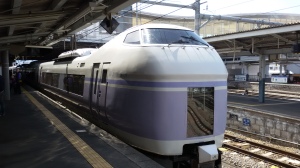
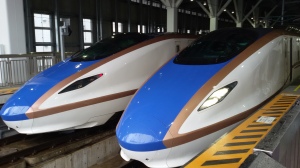
The only downside is that, as in the UK, they have a mix of JR (Japan Railways) and numerous private railway networks. Tickets and passes are not universally accepted and this can really bump up travelling costs. Sound familiar? Our best and cheapest train travels were in Russia and China, both nationalised systems. I don’t suppose they have Unions to mess it all up?
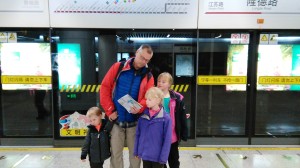
Now the Chinese have high speed trains too, but less glorified and almost identical in the looks department (probably a Japanese design at a fraction of the cost!). The whole system is less automated and relies more on old fashioned ticket windows, but a series of good travel agents have online sites which link to the national rail system and you can tell quite quickly if seats are available and in which class – first, second, third, reserved or unreserved. Japanese trains have several unreserved carriages on each train and one green car for first class travel. You don’t see numerous empty first class carriages like at home and everyone crammed into ‘standard’.
We travelled in a couple of sleeper trains in China and they were excellent. You pass through security at every Chinese station, go to your designated waiting room, buy your noodles for the trip and boarding commences 20 minutes before departure.
Actually, in both countries, food prices at stations and on board trains are not that different to those in the high street. Not a rip off ‘Virgin’ coffee or sandwich in sight.
People gave up their seats to us when they saw the children in both Russia and China. No such courtesy in Japan. The elderly, those carrying babies are left standing, while the designated priority seats are full of young Japanese workers on their phones or slumbering. We couldn’t understand the strict adherence to queuing in precise lines at every platform and the thoughtless free for all on the actual trains.
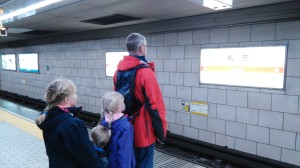
When in Rome ….
Japanese buses are as frequent and punctual as their trains. You get on at the back and take a ticket. When you reach your destination, the indicator board at the front of the bus tells you the fare corresponding to the number on your ticket. We didn’t venture onto Chinese buses for fear of having the children crushed. Not sure in either country what corresponds to a bus being full…they just keep packing them in…
Continuing the transport theme, Japanese cars are functional but not easy on the eye. They are very square, which I suppose makes them easier to stack in their fabulous multi storey car parks.
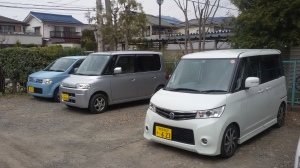
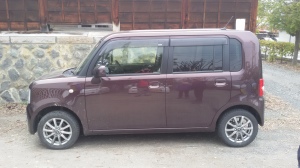
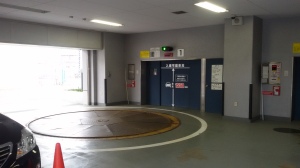
Now for food – my pet subject.
China – other than the exotic taste in anything that moves, the basic diet seems very healthy. We enjoyed rice, noodles, pan fried veg and fresh fruit for breakfast. There are numerous cheap noodle joints on every street and few ‘dessert’ outlets. The kids are all gathered around noodle or rice outlets after school. It’s such a shame that you know what’s round the corner with the advance of Western junk food. Already, you can see McDonalds in many cities and the attraction of free wifi makes it a popular hangout for kids.
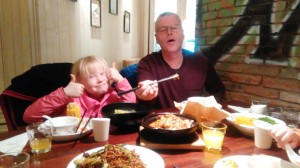
Japan has ‘enjoyed’ an American influence for longer and there is a denser concentration of fast food outlets. However, the restaurants and cafes that cater for the commuters around and in each station are mainly traditional Japanese noodle and rice places. Curry and rice, Sushi, Udon noodles, Yakatori are all mainstays. As you wander around towns, the better restaurants have long queues outside or designated waiting areas. These are normally restaurants renowned for their Udon or other specialities. In Kyoto, we saw many which had ‘closed’ signs up at 9pm as they had sufficient diners inside and out to keep their kitchens busy until closing time.
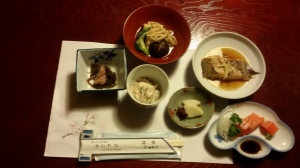
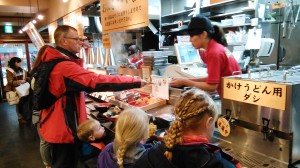
Japanese food is truly an art form. The presentation of the food is amazing and so appealing if you like fish and rice. Several times we’ve asked ourselves if the Japanese don’t get bored of endless variations of fish and rice?? Certainly the traditional Japanese diet is sooo healthy. When we stayed half board at a Ryokan in the mountains, it was like a detox. Fish (cooked and raw), other seafood, tofu, pickled veg, endless boiled rice, green tea for each meal including breakfast. Not a piece of toast or cereal in sight. Very little dairy or meat. It was the perfect ‘prostate friendly’ diet, but after 3 days, we let the side down and headed straight for ‘Mr Donut’ and the local Irish bar.
It’s a struggle to maintain a veggie diet, especially as we can’t read packaging. We’ve sometimes dived into an Indian or Chinese restaurant to have some fresh vegetable dishes we recognise.
Shops – we didn’t do a lot of food shopping in China as eating out was so cheap. It’s the opposite in Japan, where every meal out seems to come to between £30 to £50 and that’s not fine dining choices. The supermarkets have the freshest fish ever and even in their meat section, it looks fresh, lean and well presented. I’m a huge fan of the ‘bento’ box, which gives you a healthy low fat lunch for about £3 or £4.
However, there is a huge amount of junk food on sale with pot noodles, packets of mixes, sauces, crisps, sweets etc. Imported foods like cheese, pasta, olive oil and pesto are relatively expensive. The mainstay is fish, fish, fish ….
The convenience stores are everywhere – 7-11, Lawsons, Family Mart. They stay open 24 hours and sell ready meals, alcohol and have print facilities and ATM’s. Post Offices and 7-11’s are the only places guaranteed to accept our ‘foreign’ cards for cash withdrawals. It’s another anomaly in such a high tech country. The same with online bookings, which can only be made during office hours. You can’t book e.g. a coach ticket online at midnight, you have to wait until the office opens. The fact that you can buy alcohol 24 hours doesn’t lead to any undesirable behaviour either. Oh and there are vending machines everywhere. You never seem to be more than 50m from a drinks machine even in the smallest village. There are vending machines which sell everything, batteries, canned hot drinks, miso soup stock, tea by the litre ….
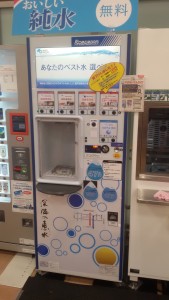
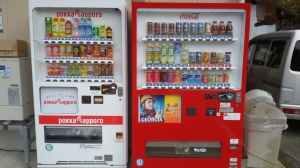
Relaxation – saw lots of tai chi, ballroom dancing or exercise classes in any available outdoor space in China, but the way the Chinese are concreting over their open spaces and the high levels of pollution limit the options for such activities. The Japanese love their baseball, softball and Sumo. We watched the 14 day Osaka Sumo tournament on TV, which is one of the six tournaments each year that affect the rankings. It was won by a Mongolian. Apparently the foreign wrestlers so dominate the sport that several years ago the Japanese governing body limited the number
of foreigners that each Sumo stable could have to one. That seems fair!!
I ventured into a
Pachinko joint in Osaka to see what the fuss was about. Lots of people in the middle of the day, smoking and watching metal balls falling through slot machines, which were then collected in shopping baskets. The noise was deafening.
We’ve spend most of this week in our local park in Tokyo. There are exercise machines and a walking track and it is well used by some very elderly looking Japanese. One lady today was almost bent double with a spinal condition, but was still doing laps of the track. Generally, their pensioners look a lot fitter than ours and the statistics support this. They’ve only recently abandoned their message from the Emperor as so many people are now over 100.
Living – If you are Chinese, it doesn’t pay to be afraid of heights as most new accommodation goes straight up. Endless, clusters of ugly high rise everywhere often clouded in pollution hazes.
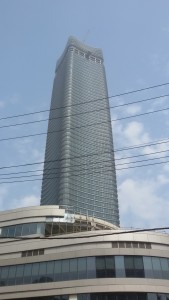
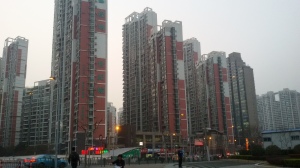
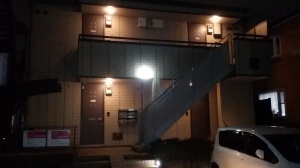
In Japan, it’s still a mix of flats and houses. The houses are functional and the people generally don’t seem to focus on their gardens. There’s an element of shanty town about many streets with power cables running everywhere and boxed grey functional housing. The houses that we have rented through Airbnb have small kitchens, as they don’t normally entertain at home. A lot of gadgets and everything working perfectly, although we have needed to look up the manual for how to use some.
We’ve enjoyed some nice picnics in the local parks and you often see large groups of people eating, laughing and chilling together. A contrast to the unhappy looking commuters waiting in long queues at train and bus stops not talking, engrossed in their mobiles. The mass of Chinese are poorer, but we heard much more laughter there.
Miscellaneous
- Caroline wanted a Chinese baby until she got to Japan, where she wanted a Japanese one. She would settle for one of each as they are gorgeous.
- Not quite sure why so many dress like school girls with the white socks and shoes they can’t walk in and what can we say about the Ganguro look – see the photo below (darkened skin with contrasting pale accessories?)

- Japanese shop assistants bow to the shop floor before they leave for the store room.
- It seems acceptable for Chinese staff to sleep at their desks during quiet periods.
- Japanese train staff bow to the carriage on entering or leaving. Station staff salute passing trains.
- Japanese Sakura Blossom have the best marketing team ever, bringing in tourists from all over the world for a few flowers. Guys, really, it’s just blossom! We have orchards full of it in Kent, and it produces fruit there.
- As Westerners, we were treated with a great deal of respect in China – I remember similar in Turkey many years ago. Whilst they are unlikely to become the mass stag/hen party venue destination in the near future, I am sure their first International Football Tournament will soon have them reassessing their view of us.
- It’s impossible to find a litter bin in Japan. Recycling is no problem, although the man in Lawson’s today watched our every move as we deposited four wine bottles and six empty beer cans in his precious bins. Probably because we hadn’t bought the booze there…..
Overall, we feel as if we have over-stayed in Japan by two weeks and want to leave. We wished that we had seen more of China, especially the rural parts. Japan has made a serious dent in our budget. Even the youth hostels were costing us £120 a night, the hotels around £200 (without breakfast) and the airbnb’s about £50 to £120 a night. Eating from supermarkets about £35 – 40 a day in Japan, whereas China was about a third or quarter of this.
Two very different places with lots to see and eat … especially if you like fish!
DISCLAIMER: the article above represents the views of one member of the O’Sullivan family and does not necessarily reflect those of the others … except the bit about fish and noodles 🙂 Ha ha.

We are Caroline and Ian. We undertook an adventure, packing up everything and travelling with our three children. Our blog started as a way of capturing our memories of the preparation and interesting aspects of our journey. After a twist of fate, we returned back to the UK much sooner than expected so who knows what's next for us now we're back home with our three kids in tow!











